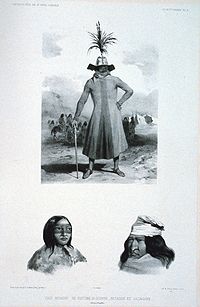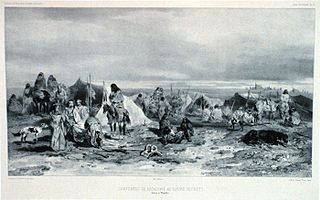
Patagon
Encyclopedia

Mythology
The term mythology can refer either to the study of myths, or to a body or collection of myths. As examples, comparative mythology is the study of connections between myths from different cultures, whereas Greek mythology is the body of myths from ancient Greece...
race of people, who first began to appear in early European accounts of the then little-known region and coastline of Patagonia
Patagonia
Patagonia is a region located in Argentina and Chile, integrating the southernmost section of the Andes mountains to the southwest towards the Pacific ocean and from the east of the cordillera to the valleys it follows south through Colorado River towards Carmen de Patagones in the Atlantic Ocean...
. They were supposed to have exceeded at least double normal human height, some accounts giving heights of 12 to 15 ft (3.7 to 4.6 m) or more. Tales of these improbable people would take a hold over European concepts of the region for some 250 years, until they were substantially debunked at the end of the 18th century.
First mention of these people came from the voyage of Ferdinand Magellan
Ferdinand Magellan
Ferdinand Magellan was a Portuguese explorer. He was born in Sabrosa, in northern Portugal, and served King Charles I of Spain in search of a westward route to the "Spice Islands" ....
and his crew, who claimed to have seen them while exploring the coastline of South America en route to their circumnavigation
Circumnavigation
Circumnavigation – literally, "navigation of a circumference" – refers to travelling all the way around an island, a continent, or the entire planet Earth.- Global circumnavigation :...
of the world in the 1520s. Antonio Pigafetta
Antonio Pigafetta
Antonio Pigafetta was an Italian scholar and explorer from the Republic of Venice. He travelled with the Portuguese explorer Ferdinand Magellan and his crew on their voyage to the Indies. During the expedition, he served as Magellan's assistant and kept an accurate journal which later assisted him...
, one of the expedition's few survivors and the chronicler of Magellan's expedition, wrote in his account about their encounter with natives twice a normal person's height:
- "One day we suddenly saw a naked man of giant stature on the shore of the port, dancing, singing, and throwing dust on his head. The captain-general [i.e., Magellan] sent one of our men to the giant so that he might perform the same actions as a sign of peace. Having done that, the man led the giant to an islet where the captain-general was waiting. When the giant was in the captain-general's and our presence he marveled greatly, and made signs with one finger raised upward, believing that we had come from the sky. He was so tall that we reached only to his waist, and he was well proportioned..."
Pigafetta also recorded that Magellan had bestowed on these people the name "Patagão" (i.e. "Patagon", or Patagoni in Pigafetta's Italian plural), but did not further elaborate on his reasons for doing so. Since Pigafetta's time the assumption that this derived from pata or foot took hold, and "Patagonia" was interpreted to mean "Land of the Bigfeet". However, this etymology
Etymology
Etymology is the study of the history of words, their origins, and how their form and meaning have changed over time.For languages with a long written history, etymologists make use of texts in these languages and texts about the languages to gather knowledge about how words were used during...
remains questionable, since amongst other things the meaning of the suffix -gon is unclear. Nevertheless, the name "Patagonia" stuck, as did the notion that the local inhabitants were giants. Early maps of the New World
New World
The New World is one of the names used for the Western Hemisphere, specifically America and sometimes Oceania . The term originated in the late 15th century, when America had been recently discovered by European explorers, expanding the geographical horizon of the people of the European middle...
afterwards would sometimes attach the label regio gigantum ("region of giants") to the area.

In the 1590s, Anthonie Knivet claimed he had seen dead bodies 12 feet (3.7 m) long in Patagonia.
Also in the 1590s, William Adams, an Englishman aboard a Dutch ship rounding Tiera del Fuego reported a violent encounter between his ship's crew and unnaturally tall natives.
In 1766, a rumour leaked out upon their return to Britain
United Kingdom
The United Kingdom of Great Britain and Northern IrelandIn the United Kingdom and Dependencies, other languages have been officially recognised as legitimate autochthonous languages under the European Charter for Regional or Minority Languages...
that the crew of HMS Dolphin
HMS Dolphin (1751)
HMS Dolphin was a 24-gun sixth-rate frigate of the Royal Navy. Launched in 1751, she was used as a survey ship from 1764 and made two circumnavigations of the world under the successive commands of John Byron and Samuel Wallis. She was the first ship to circumnavigate the world twice...
, captained by Commodore
Commodore (rank)
Commodore is a military rank used in many navies that is superior to a navy captain, but below a rear admiral. Non-English-speaking nations often use the rank of flotilla admiral or counter admiral as an equivalent .It is often regarded as a one-star rank with a NATO code of OF-6, but is not always...
John Byron
John Byron
Vice Admiral The Hon. John Byron, RN was a Royal Navy officer. He was known as Foul-weather Jack because of his frequent bad luck with weather.-Early career:...
, had seen a tribe of 9 feet (2.7 m) natives in Patagonia when they passed by there on their circumnavigation of the globe. However, when a newly-edited revised account of the voyage came out in 1773, the Patagonians were recorded as being 6 ft 6 in (1.98 m); very tall, but by no means giants.
The people encountered by Byron were in all likelihood the Tehuelches, indigenous to the region. Later writers consider the Patagonian giants to have been a hoax
Hoax
A hoax is a deliberately fabricated falsehood made to masquerade as truth. It is distinguishable from errors in observation or judgment, or rumors, urban legends, pseudosciences or April Fools' Day events that are passed along in good faith by believers or as jokes.-Definition:The British...
, or at least an exaggeration and mis-telling of earlier European accounts of the region.

